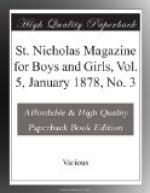You will remember what I said about insulation,—how a tiny hole in the gutta-percha would allow the electricity to escape. On deck there is a small house, which is filled with delicate scientific instruments. As the cable is paid out, it is tested here. If a wire or a nail or a smaller thing is driven through it, and the insulation is spoiled, an instrument called the galvanometer instantly records the fact, and warning is given at all parts of the ship. The man in charge touches a small handle, and an electric bell rings violently in the tank and at the paying-out machinery. At the same time a loud gong is struck, at the sound of which the engines are stopped. Delay might cause much trouble or total failure, as the injured section must be arrested and repaired before it enters the water.
The great steamer went ahead at the rate of five nautical miles an hour, and the cable passed smoothly overboard. Messages were sent to England and answers received. The weather was bright, and all hands were cheerful. On the third day after the “splicing” of the shore-end with the main cable, that part of the ocean was reached where the water suddenly increases in depth from two hundred and ten fathoms to two thousand and fifty. One of the earlier cables broke at this place and was lost forever. The electricians and engineers watched for it with anxious eyes. It was reached and passed. The black cord still traveled through the wheels unbroken, and the test applied by the galvanometer proved the insulation to be perfect. The days wore away without mishap until the evening of July 17, when the sound of the gong filled all hearts with a sickening fear.
The rain was falling in torrents and pattering on the heavy oil-skin clothing of the watchers. The wind blew in chilly gusts, and the sea broke in white crests of foam. A dense and pitchy cloud issued from the smoke-stacks. The vessel advanced in utter darkness. A few lights were moving about, and shadows fell hither and thither as one of the hands carried a lantern along the sloppy deck. The testing-room was occupied by an electrician, who was quietly working with his magical instrument, and the cable could be heard winding over the wheels astern, as the tinkling of a little bell on the “drum” recorded its progress.
[Illustration: THE “GREAT EASTERN” ENTERING THE BAY OF HEART’S CONTENT.]
The electrician rose from his seat suddenly, and struck the alarum. The next instant each person on board knew that an accident had happened. The engines were stopped and reversed within two minutes. Blue-lights were burned on the paddle-boxes, and showed a knot in the cable as it lay in the trough.
Two remedies seemed possible. One was to cut the cable, and support one end in the water by a buoy until the rest could be unraveled. The other was to unravel the cable without cutting it.
[Illustration]
It is a very intricate knot that an old sailor cannot untie, and the old sailors on the “Great Eastern” twisted and untwisted coil after coil until they succeeded in untying this one. The insulation remained perfect, and in a few hours all was right again. The accident caused much ill foreboding, however, as it showed how slight an occurrence might bring the expedition to a disastrous end.




